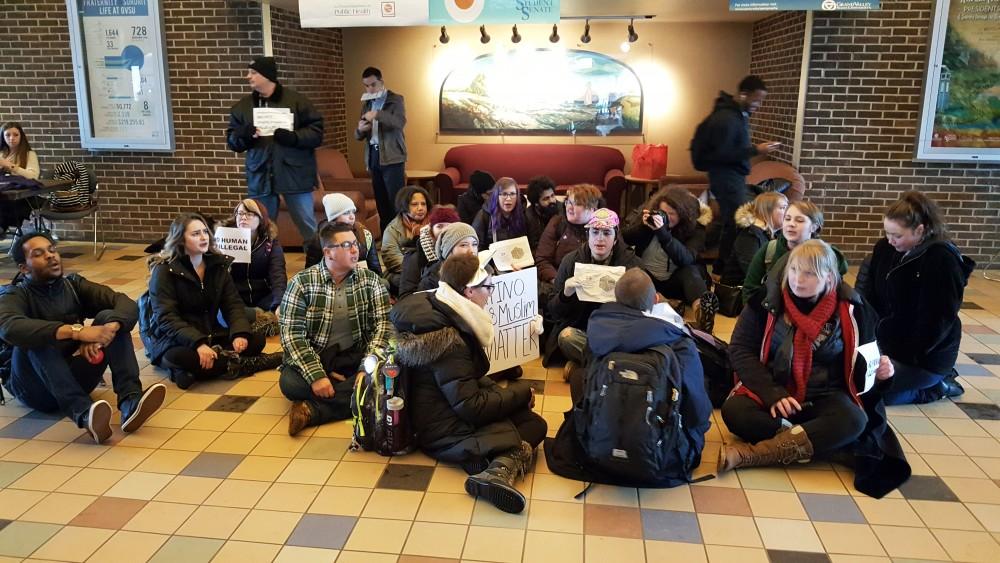Creating a safe place

GVL / Courtesy – Jason Blanks Students gather inside the Kirkhof Center on Tuesday, Jan. 31, 2017 in protest of President Trump’s immigration ban.
Feb 2, 2017
With protests against President Donald Trump occurring across the U.S. and worldwide after his controversial election, students, community members and U.S. residents in general have had a lot to say about Trump’s recent executive orders.
One of the issues gaining the most attention is Trump’s decision to put in place an order turning back refugees and other visitors from predominantly Muslim countries.
In congruence with the national and international protests with the executive order considering refugees, members from the Grand Valley State University community hosted the “Grand Valley Student Sit-in Against Trump” Tuesday, Jan. 31, in the Kirkhof Center on the Allendale Campus. Though the protest looked to show vocal and physical support of refugees in general, the protest also hit closer to home as it was also a commentary in response to an email sent out to students, faculty and staff of GVSU from university president, Thomas Haas.
In the email, Haas touched on the stance of the university in reference to Trump’s executive order on immigration and how that will impact international travel and student’s privacy. Haas mentions that “the university does not release any private student information or records” due to the Family Education Rights and Privacy Act (FERPA). The university also prioritizes and focuses on welcoming students of all backgrounds without thought of immigration status, religion or race Haas said.
However, student protesters at GVSU want more from Haas and the university including a clear, supportive stance on resistance of Trump’s order and the declaration of the university as a “sanctuary campus.”
Megan Bardenhagen, organizer of the sit-in as well as the “Not My President” rally Friday, Nov. 11, 2016 at GVSU, said the purpose of the sit-in was to create a forum for discussion among the GVSU community about Trump’s stance on various social and political issues.
“He (Trump) was elected based on a foundation of white supremacy, what this country was built on, and I think we need to take a stand to change that and reshape our values and beliefs,” she said.
Chants of “No ban, no wall, this country is for all” and “Show me what democracy looks like – this is what democracy looks like” resonated throughout the Kirkhof Center, with various students, faculty and staff members walking by or stopping to listen to the group as they discussed ways of making GVSU a sanctuary campus.
Limiting cooperation with federal immigration authorities, sanctuary campuses are any college or university in the U.S. that adopts policies to protect undocumented student immigrants. Universities like Portland State University and Reed College are among the few universities in the country to officially declare they are sanctuary campuses.
Joe Cadreau, a member of the Native American Student Association (NASA) at GVSU as well as several other student groups also attended the event and spoke to students about the need to make their voices heard.
“This just started out as a coalition of students and student orgs and an idea of people getting together and deciding that this is something they needed to take a stand on,” Cadreau said.
Cadreau said after Michigan State University and the University of Michigan took firm stances on the immigration ruling, it is now GVSU’s turn to do the same.
Beyond talks of making GVSU a sanctuary campus, some of the students within the sit-in shared their fears for the future and hopes for the future.
Sudhansu Baskota, a freshman and international student at GVSU, discussed his experience with racial profiling and the overall unease he felt after the experience.
“I got stopped there (48th Avenue), the cop asked me for my passport and asked me ‘Do you have a visa?’ and he just took the passport right out of my hand,” he said. “Then he came out of the car, he came out with his hand on his gun and all I was trying to do was cross the street. I guess the only thing I did that was ‘quote, unquote’ against the law was that I tried to cross the road with no signal passing.”
Talking about the Monday, Jan. 30, experience, Baskota said he had his hands in pockets when the incident happened and he felt if he removed his hands, he thought the police officer would have shot him.
He eventually took the bus from 48th Avenue, went to Kirkhof and texted a friend to pick him up and take him back to her place so he could calm down.
“I was scared to go back, I was scared to go outside,” he said. “Just last night (Monday) I got a message from one of my friends to ask me if I would speak (at the sit-in). There are people being detained at airports and it’s a human rights issue – we just want to be safe.”
On a larger scale, following the news of Trump’s immigration ban, thousands of New Yorkers flooded the JFK International Airport Saturday, Jan. 28, to protest Trump’s executive order, which prohibited residents from seven Muslim-majority countries for 90 days, shutting down refugee resettlement for 120 days. Mobilized through social media, later demonstrations began at Los Angeles International Airport (LAX), Seattle’s SeaTac Airport and a motely of other airports throughout the U.S.
Additionally, Thursday, Jan. 16, protesters in West Michigan filled up the Blue Bridge in downtown Grand Rapids to protest the immigration orders with signs like “Jesus was a refugee” and “Welcome, refugees.”
GVSU students, however, have no plan to give up on protesting the Trump administration any time soon with plans for other forms of protest in the future.























